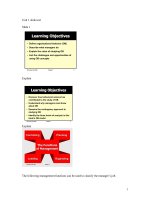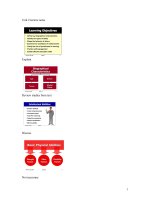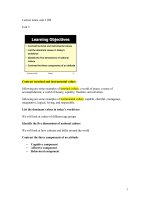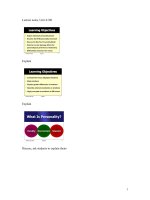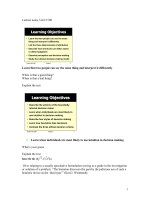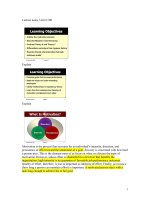Organizational behavior: Lecture 25 - Dr. Mukhtar Ahmed
Bạn đang xem bản rút gọn của tài liệu. Xem và tải ngay bản đầy đủ của tài liệu tại đây (311.33 KB, 36 trang )
Organizational
Behavior
(MGT-502)
Lecture-25
Summary
of
Lecture-24
Concept of Power
Power - the ability to influence another
person
Influence - the process of affecting
the thoughts, behavior, & feelings of
another person
Authority - the right to influence
another person
Sources of Organizational
Power: Interpersonal
Reward Power - agent’s ability to control the rewards that
the target wants
Coercive Power - agent’s ability to cause an unpleasant
experience for a target
Legitimate Power - agent and target agree that agent has
influential rights, based on position and mutual agreement
Referent Power-based on interpersonal attraction
Expert Power - agent has knowledge target needs
Dependency:
The Key To
Power
Two Faces of Power
Personal Power
– used for personal gain
Social Power
– used to create motivation
– used to accomplish group
goals
Today’s Topics
Contingency Variables that
Influence Use of Power Tactics
o Manager
– Personality
– Relative Power
– Objectives for wanting to influence
o Employee
– Perception of employee’s willingness and
ability to comply
o Organization Culture
Examples: Power & its
Use in Organizations
oDifferent forms of harassment
oPolitical behavior
oGroups & coalitions
oImpression management
oEthics and Power
The Power Corruption Cycle
Power and Resources
with no Accountability
Employee Reactions
Compliance
Submission
Dependence
Distance from
Employees
Consequences
Inflated View
Poor Decisions
Coercion
Lower Morale
Ethics Violations
Political Behavior in
Organizations
Organizational Politics - the use of
power and influence in organizations
Political Behavior - actions not officially
sanctioned by an organization that are
taken to influence others in order to meet
one’s personal goals
“Playing Politics” in an
Organization
• Game Playing
– Political behavior in organizations has been
described by many researchers in terms of
game playing.
• Political Influence Tactics
– Individuals and groups engage in political
behavior in order to influence the perceptions
or behavior of other individuals and groups.
“Playing Politics” in an
Organization
• Impression Management
– A political strategy which refers to actions
individuals take to control the impressions
that others form of them. It represents a
deliberate attempt to leave a desirable
impression on others. The desired
impression may or may not be an accurate
one.
Political Activity is Likely (range 0-3)
Political Activity Levels
Political activity
is perceived to
increase at higher
organizational levels
1.3
1.2
1.1
1.0
(1.22)
(1.07)
.9
(.73)
.8
.7
.6
(.50)
.5
(.54)
.4
.3
.2
(.18)
.1
Production Clerical Technical and
blue collar
professional
Lower
Mgmt.
Middle
Mgmt.
Organizational Level
Upper
Mgmt.
Political Maneuvering
in Organizations
Political maneuvering
Political strategy
Plan to reach a goal using specific
political tactics
Goal: organizational or personal
Political tactics
Builds power base
Uses power
Political Maneuvering
in Organizations (Cont.)
Political strategy
Specifies combinations and
sequences of political tactics
Includes plan for responding to
changes in the political context
People at all levels can develop and
use a political strategy
Not written; usually tacit
Political strategy (cont.)
Used in
Resource allocation
Choice of senior managers
Career decisions
Performance appraisals
Pay increase decisions
Political tactics
Decision making processes
Selectively emphasize decision
alternatives
Influence decision process in favor of
self or work unit
Control the decision making
agenda: often done when person
does not want change
Political tactics (cont.)
Build coalitions
Form around people inside and
outside the organization
Those believed important to person’s
position
Co-optation:
get support by putting
possible opponents on a task force or
advisory board
Political Tactics
1) Attacking or blaming others
2) Using information as a
political tool
3) Creating a favorable image
(impression management)
4) Developing a base of support
5) Praising others (ingratiation)
6) Forming political coalitions
with strong allies
7) Associating with influential
people
8) Creating obligations
(reciprocity)
Influence Tactics
Consultation
Rational persuasion
Inspirational appeals
Ingratiation
Upward appeals
Coalition tactics
Exchange tactics
Pressure
Upward Influence
the boss
Lateral Influence
a coworker
Downward Influence
an employee
Individual Factors Which Contribute
to Political Behavior
• Level of self monitoring
• Need for power
• Internal locus of control
• Investment in the organization
• Perceived alternatives
• Expectations of success
Organizational Factors
Which Contribute to
Political Behavior
• Low trust
• Role ambiguity
• Democratic
decision making
• Self-serving senior
managers
• High performance
pressures
• Scarcity of
resources
• Unclear evaluation
systems
• Zero-sum allocations
Types of Organizational
Politics
Managing
impressions
Creating
obligations
Attacking and
blaming
Types of
Organizational
Politics
Cultivating
networks
Controlling
information
Forming
coalitions
Conditions for Organizational
Politics
Personal
Characteristics
Scarce
Resources
Conditions
Supporting
Organizational
Politics
Tolerance of
Politics
Complex and
Ambiguous
Decisions


